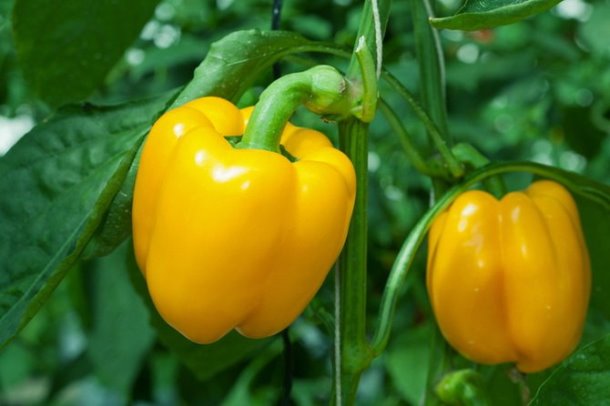 A variety of sweet peppers allows any summer resident to choose a suitable variety for themselves according to their taste and beauty. Of all the varieties of culture there are vegetables that are similar in taste to each other, but are excellent in color. So, for example, the variety "Yellow Bull" is a variety of yellow peppers, is also a high-yielding variety and has other advantages.
A variety of sweet peppers allows any summer resident to choose a suitable variety for themselves according to their taste and beauty. Of all the varieties of culture there are vegetables that are similar in taste to each other, but are excellent in color. So, for example, the variety "Yellow Bull" is a variety of yellow peppers, is also a high-yielding variety and has other advantages.
Content
- 1 Characterization and description of the variety. Productivity, photo
- 2 Where and how to grow
- 3 Interesting features of the root system and plant stem
- 4 The main stages of growth
- 5 What is required to grow healthy fruits
- 6 Disease and virus resistance
- 7 The purpose of the variety and storage conditions, reviews
- 8 To summarize
Characterization and description of the variety. Productivity, photo
Yellow Bull Pepper is a mid-early ripening hybrid. For 95-110 days, a period passes from seedlings to technical ripeness of the fruit (when the fruit is juicy and fleshy green, you can already eat it). Biological ripeness (fruits turn yellow) occurs on the 100th - 180th day.
The shape of the fruit is elongated, up to 200 mm, diameter up to 90 mm, wavy with three or four nests. Fruits grow up to 180-200 grams, are very juicy, have a sweet taste and a delicate, barely noticeable aroma. Productivity is 8-10 kg / sq.m.
Where and how to grow
Since Yellow Bull pepper is a heat-loving plant, and its ripening period is from 3 months, it is grown in open ground in the southern regions of Russia: in the Krasnodar and Stavropol Territories, in the Lower Volga Region (Astrakhan Region) and the North Caucasus. In other areas, it can be fully grown only in film and winter greenhouses.
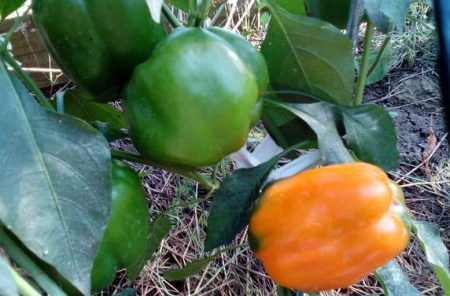
The most amazing thing is that this pepper belongs to perennial plants and can grow and bear fruit all year round in a subtropical climate! But even in the middle zone or in the south of Russia, if you transfer it for the winter from open ground to a warm room, the fruiting will continue.
Interesting features of the root system and plant stem
It is important to note that the root system of pepper has two characteristics: both core and fibrous. Before transplanting the plant, the root has only a stem.
Most of the roots are fixed in the upper part of the soil. They are the most sensitive to cold. The most active phase of root development is before fruit formation, after which their growth slows down.
The stem of the plant is soft and grassy at the beginning of growth, gradually stiffens at the base and becomes hard and very resistant to stress with age. Peppers can reach heights of up to 150 cm.
Another interesting property of a plant stem is that it can branch and take 3 different forms:
- Stamp (one stalk).
- Half-stem (1-3 shoots at the base).
- Branched (branches almost at the root).
Each shoot gives 1-2 fruits.
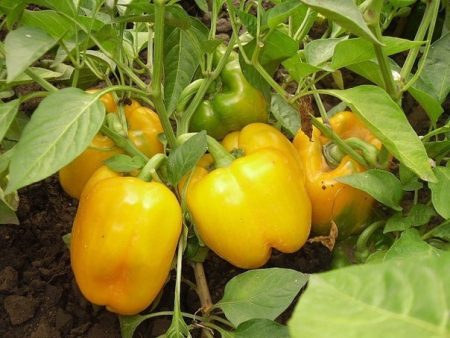
The main stages of growth
Unlike many other vegetable crops (tomatoes, cucumbers), the plant develops quite slowly at the initial stage. Let's see the table:
| The first true leaf appears | Bud formation | Bloom | Technical maturity | Biological maturity |
|
On day 10-15 after seed germination. |
50-80 days | 14-20 days after the bud | 95-110 days | 100-180 days |
The leaves are dark green in color, have an ovoid shape, located on the branches both individually and in a rosette. In their mass, they make up a fourth of the entire plant. Two germinal (cotyledonary) leaves live up to 2 months, then they turn yellow and die off, because their leaves take on the function of producing food for the plant.
The flowers of the “Yellow Bull” of white color are revealed first on the shoots of the first and second tier and only then on the central stem. The pepper has a wonderful property - there are both male and female flowers, so it can self-pollinate. Acceptable for him and cross-pollination of alien pollen.
Pepper blooms actively, but when new fruits arise, this process slows down. It is amazing that it is only necessary to collect ripened peppers, as it blooms with renewed vigor. Flowering continues until frost hits. But already at a temperature of +5 °With he stops growing.
The very first fruits of pepper are used on seeds when they reach biological ripeness, acquiring a saturated yellow color. Seeds are flat, light yellow, are slightly curved, do not lose their germination until 34 years old. In the 1st gram they contain 100-200 pieces.
What is required to grow healthy fruits
The main requirement is a sufficient amount of light and heat. Lack of seedlings of light leads to poor flowering and poor fruit setting, and the stems are brittle. The result is a very low yield.
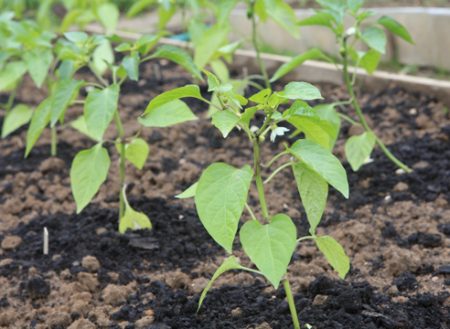
Pepper seedlings for full development, it is necessary to receive light about 12 hours a day.
Yellow bull pepper is very heat-loving and the heat is above 30°With the transfer, too, it can, just hit the growth, and the flowers will not be pollinated and fall. And if some fruits are tied, they will be small and curved. Optimum temperatures:
- +20-25°C - for seedlings.
- +17-22°C is for an adult plant.
Watering water is rarely necessary for peppers, but should be plentiful. Most of all he consumes water during fruiting, and this is almost the entire life cycle. Drying of the soil even for a short time leads to falling of buds and a decrease in productivity.
From the soil, pepper prefers black soil with a good humus content. It improves fruiting after organic top dressing and top dressing with micronutrient fertilizers. But an excess of nitrogen in the soil only leads to an increase in the vegetative mass of the plant and to a deterioration in the quality of the fruit.
Disease and virus resistance
The main advantage of pepper is its excellent resistance at the genetic level to the tobacco mosaic virus. This is very important, because antiviral drugs have not yet been developed by scientists. This virus, affecting the leaves, destroys chlorophyll in the cells, and this can lead to the death of the whole plant in a matter of days. Learn more about sweet pepper diseases.
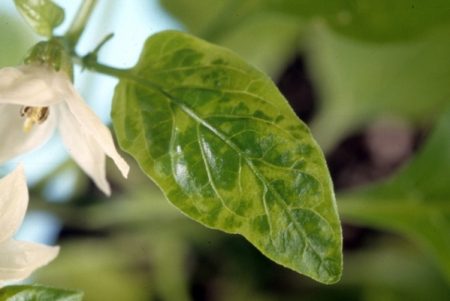
The purpose of the variety and storage conditions, reviews
The variety “Yellow Bull” is intended for fresh consumption, for canning and freezing. A good advantage of the fruit of fresh pepper is its low calorie content (per 100 grams - 29 kcal). The vegetable is very juicy because it is 91% water. It contains less antioxidant like lycopene than red sweet peppers, but it is rich in macrocell potassium and abounds in iron.
Storage
Biologically ripe peppers are best preserved in the refrigerator at a temperature of +25°C and humidity 80-90% (almost up to six months). It does not lose its properties even with quick freezing in the freezer. When storing fruits in the lower compartment of the refrigerator, it is best to wrap each with plain paper. This will prevent the spread of rot (if it suddenly accidentally penetrated) from the affected fetus to a healthy one.
Peppers are also well stored in the cellar or basement at the same temperature conditions as in the refrigerator. It is only necessary to carry out regular ventilation of the room.
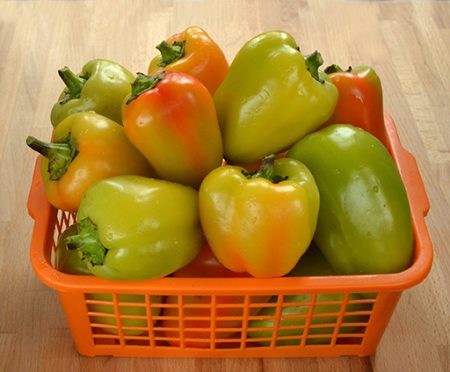
It is a big mistake to keep pepper in the light - the individual parts become soft, and the process of decay occurs.
For storage in the freezer, the fruits (both whole and cut into slices) are well pre-placed in a plastic bag. This will prevent them from drying out quickly. There they can be stored for more than six months.
Reviews
The reviews of all who have already eaten this variety of pepper are just excellent. It is delicious, and beautiful, and wonderful to diversify any dish.
Those who have already grown such pepper are satisfied with its productivity (up to 9 kg per 1 sq. M in open ground) and recommend that others plant this crop in their areas.
To summarize
If you have already tried the “Yellow Bull” to taste, then it would be nice to grow it in your country house. It is very interesting to trace all stages of development of this variety and enjoy its beautiful and large fruits. Follow all the requirements of agricultural technology of culture, and its harvest will surprise you.




 Calorie pepper stuffed with meat and rice - BZHU per 100 grams
Calorie pepper stuffed with meat and rice - BZHU per 100 grams Gorky pepper - the best varieties for open ground
Gorky pepper - the best varieties for open ground Hot pepper seeds - the best varieties for open ground and reviews
Hot pepper seeds - the best varieties for open ground and reviews Capsicum tincture for hair - how to use and reviews
Capsicum tincture for hair - how to use and reviews